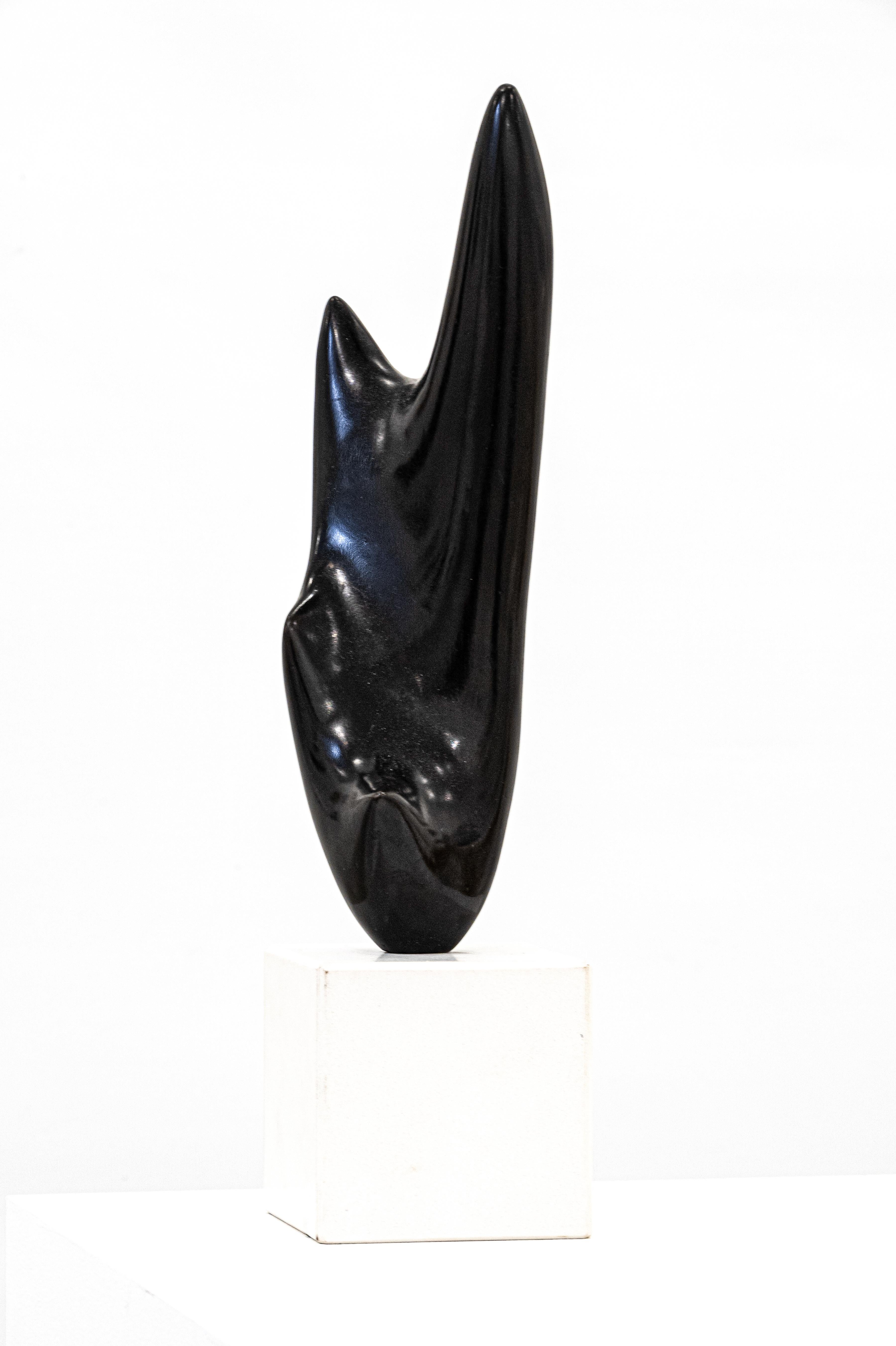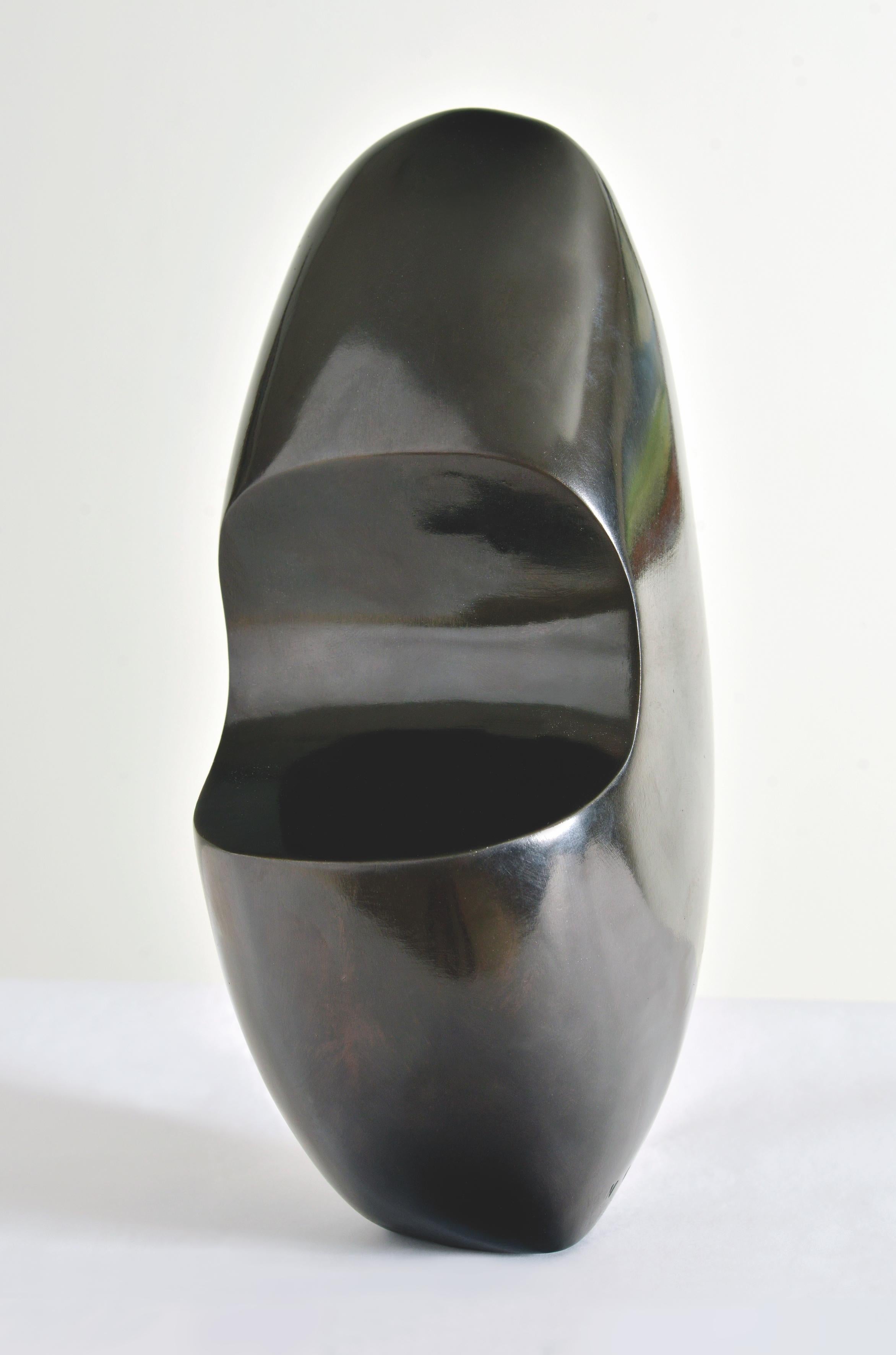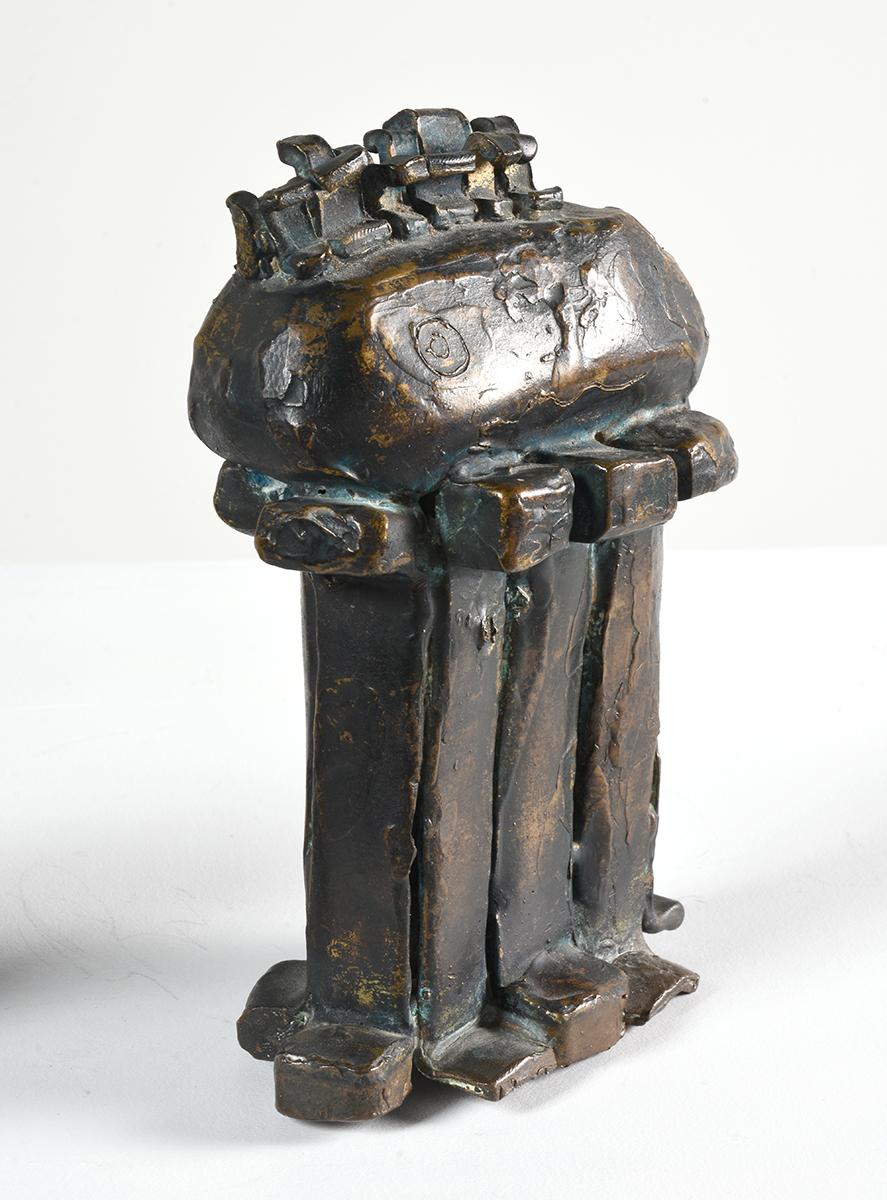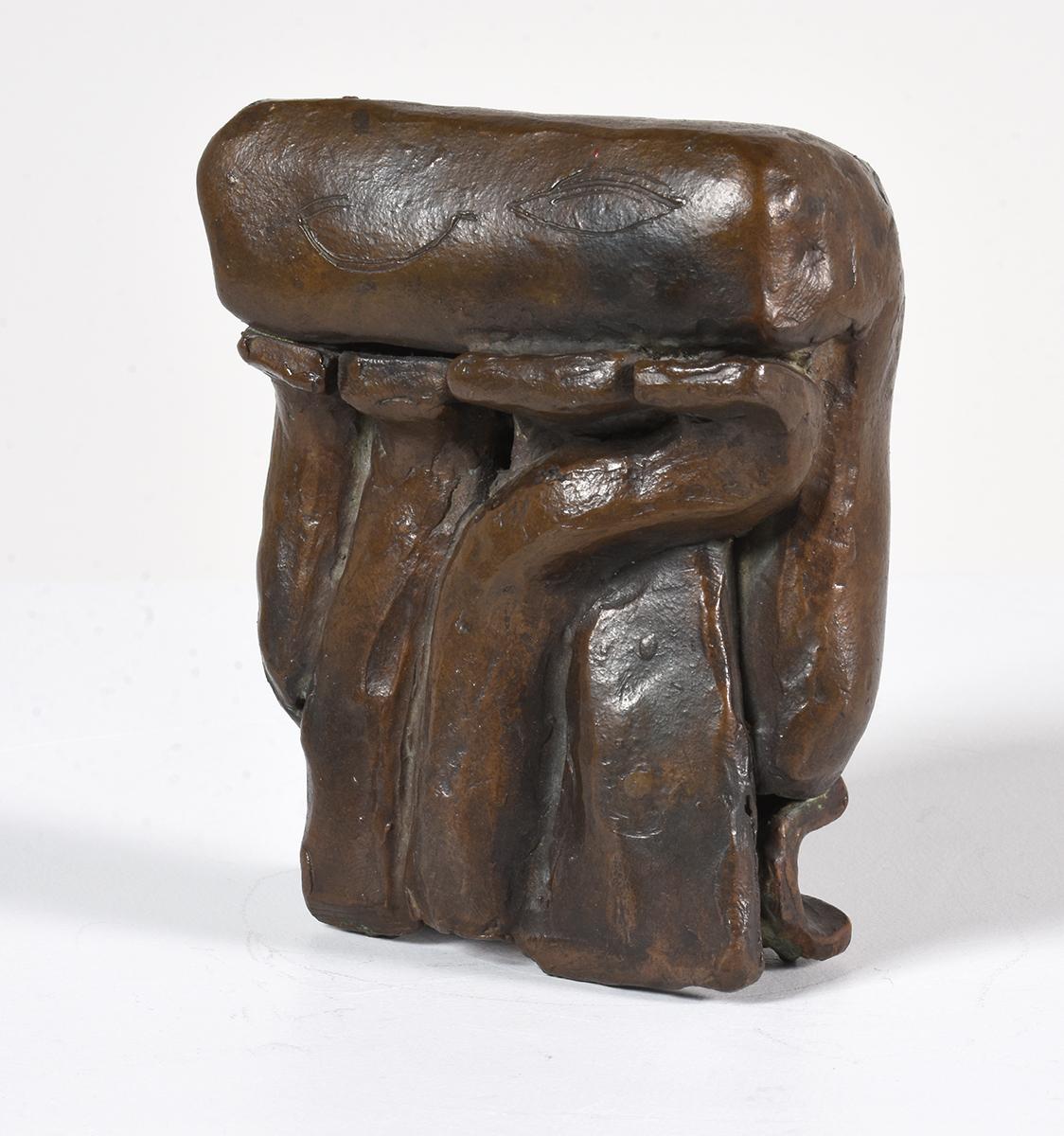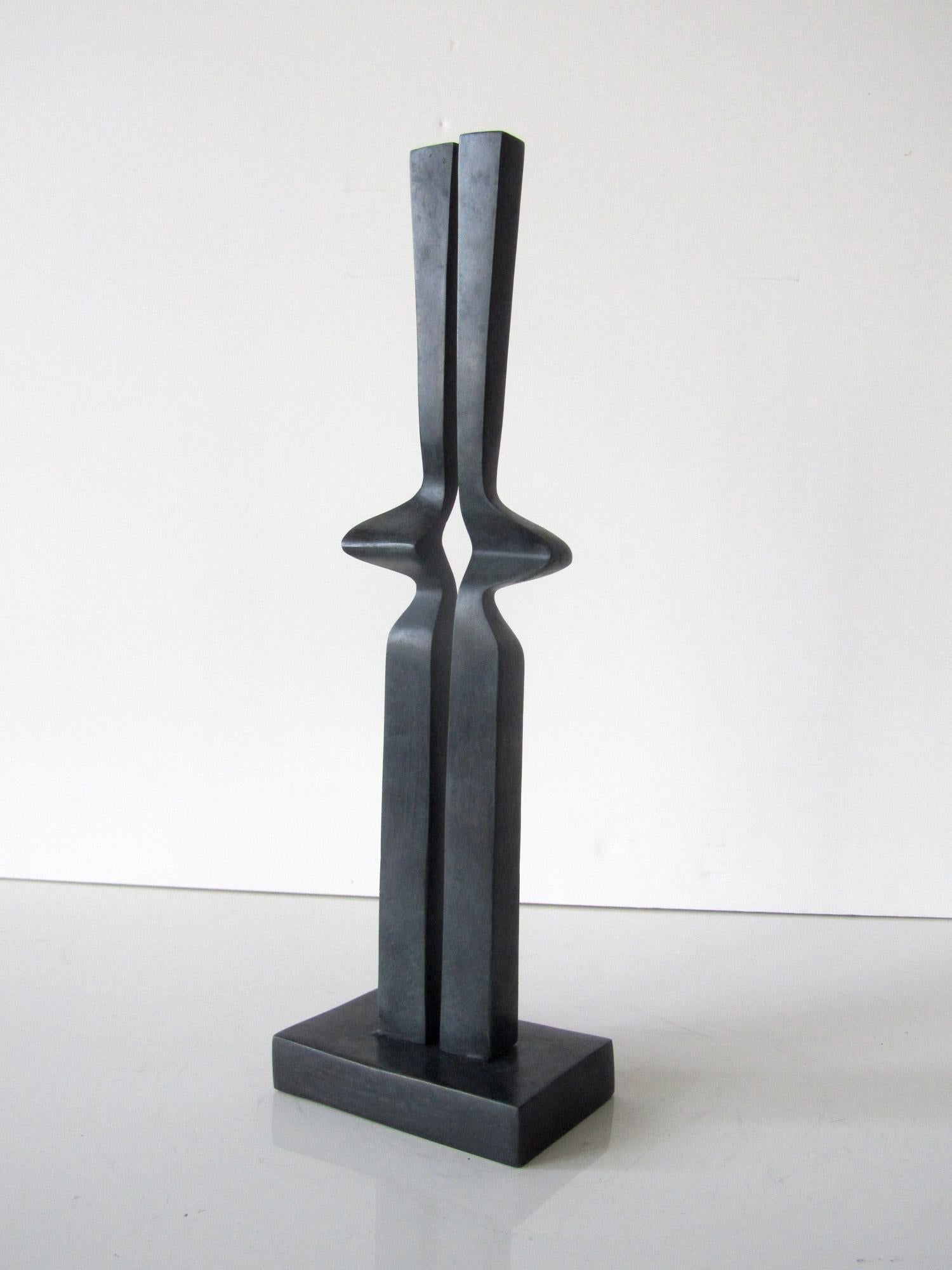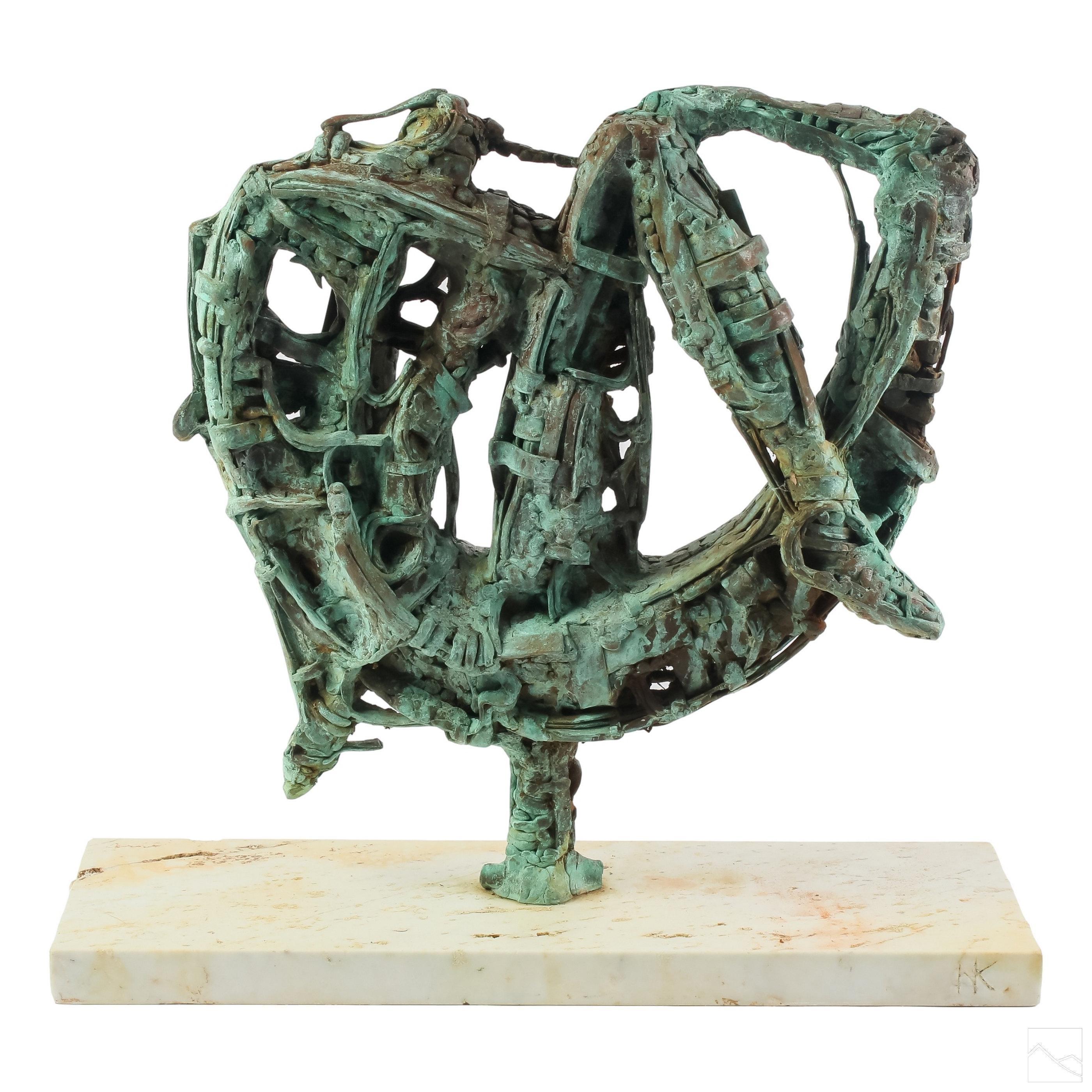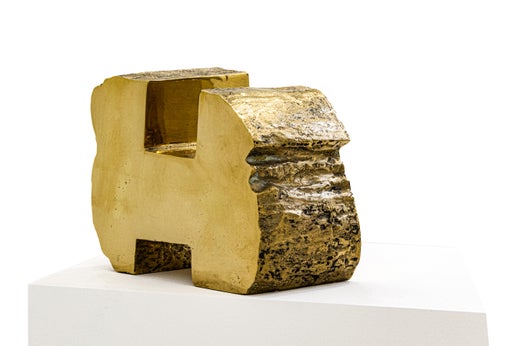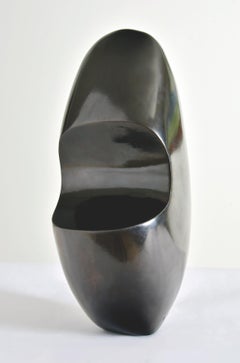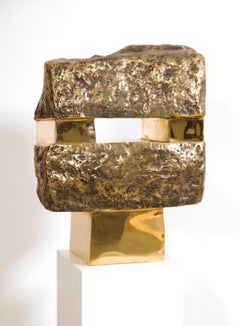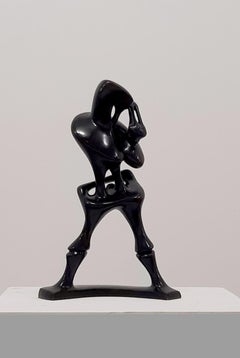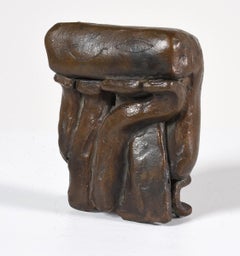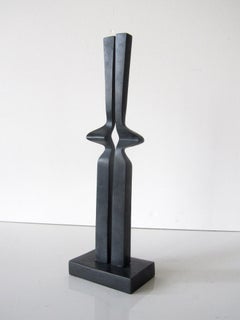Items Similar to Francisco Narváez, Volumen, 1974, Bronze, Ed. 25, 15 x 20.5 x 10.5 cm
Want more images or videos?
Request additional images or videos from the seller
1 of 8
Francisco NarváezFrancisco Narváez, Volumen, 1974, Bronze, Ed. 25, 15 x 20.5 x 10.5 cm1974
1974
$9,000
£6,786.89
€7,849.37
CA$12,626.95
A$14,035.64
CHF 7,357.18
MX$171,409.14
NOK 91,850.18
SEK 86,413.88
DKK 58,585.40
About the Item
Francisco Narváez
Volumen (BVM-002), 1974
Bronze (1974)
Edition of 25
15 x 20.5 x 10.5 cm
5.9 x 8 x 4.1 in.
LITTERATURE
El Proceso Creativo en Narvaez Visto a Traves de la Obra en Custodia
Fundacion Francisco Narvaez, 1991, p. 127
Registro General de la obra de Francisco Narváez
Fundación Francisco Nárvaez, 1ra edición, 2000, Código. BVM-002
ABOUT THE ARTIST
Narvaez was born in Porlamar, Venezuela, in 1905; he was the fifth son of eleven siblings; his parents were Jose Lorenzo Narvaez and Vicenta Rivera. Don José Lorenzo, a multifaceted and creative man, sowed the seed of creativity in his son. “My father did not fit in with his fantasies of cabinetmaker, bricklayer, master builder, and self-taught architect.”1 From an early age, Francis was led to the artistic activity, he traced, carved, made replicas of the furniture and the saints restored by his father.
In 1920 he obtained his first professional assignment, a San Rafael for the Church of Carupano, and, in 1922, his father authorized him to travel to Caracas to pursue his studies as an artist. He studied at the atelier of Marcos Castillo, at of the Angel Cabre y Magriña and at the Academy of Fine Arts in Caracas, where he was introduced to the painters and intellectuals of the time.
In 1928 he presented his first solo exhibition at the Club Venezuela. With the money raised from the sale of the works and the support of Monsignor Sosa, and the Ministers Centeno Grau and Arcaya, he studied in Paris on a scholarship. Once there, he enrolled at the Académie Julian, where Tito Salas, Cristóbal Rojas and Arturo Michelena had also studied. It was in Paris where, unable to work in wood, he turned to stone carving. “In Paris, I didn’t have wood, so I carved a lot in stone (…), when there were demolitions I purchased chunks of stone, I would take them to the workshop and carve them.”2
His first attempts at volumetric sculptures and painting in plain colours, linked to the thematic of American miscegenation and Creole reality, can be traced back to that first trip to Paris. During his stay in the French city, Arturo Uslar Pietri, Alfredo Boulton, and Finita Vallenilla supported the artist both financially and logistically, and in February of 1930, the trio of friends arranged another exhibition for him at the Club Venezuela. Narvaez describes his exhibition as follows: “(…) in it I feel that the sculptural work is more my own, done with more assurance, a response to my pursuit of large planes, stylisation and synthesis.”3 By then, as Boulton himself noted in his book about the artist, Narvaez departed from most of the artistic traditions that prevailed by that time in Venezuela.
In 1931 he returned to Caracas and established his atelier at the Barrio Obrero in Catia. The atelier became the hub of the intellectual life of the time. “In those years, the atelier of Francisco Narvaez was the hub of the greatest Venezuelan hope. Nothing comparable to it can be found either before or since.”4
From that year onwards, exhibitions, projects, trips, and awards we multiplied. He was awarded the President of the Republic of Venezuela Prize, the National Sculpture Prize of the 1st Official Venezuelan Art Salon, and the John Boulton Prize of the 3rd Annual Venezuelan Art Salon; for the Military Academy, he produced a spectacular relief entitled La Patria.
In 1945, commissioned by the architect Carlos Raúl Villanueva, he produced two groups of sculptures known as Las Toninas, both located in the O’Leary Square. There, as he himself states, he incorporates some baroque patterns into the figures to the source itself: “It is a work of balance between the decorative requirements and the sculpture of planes and angles.”5
In 1948 he was awarded the National Painting Prize. In the same year, he was called upon by the architect Carlos Raul Villanueva to participate in the project for the arts integration in the Universidad Central de Venezuela. Francisco Narvaez’s public output continued with works such as the statue of Fermín Toro, La Educacion, La Ciencia, three murals (produced by María Luisa Tovar) for the Instituto de Medicina Experimental, El Cristo; el Atleta, the equestrian statue of General Rafael Urdaneta.
In 1953 he was appointed Director of the School of Plastic and Applied Arts, and in July of the same year, he exhibited “Francisco Narvaez, Maderas, Piedras y Bronces” (Francisco Narvaez, Woods, Stones and Bronzes) at the Museum of Fine Arts.
Narvaez is, unquestionably, one of the great Venezuelan sculptors, his work goes through various stages and interests; as the art world evolves, the artist does not remain in his initial scopes of work. His creations are not imposed by the prevailing trends or fashion but do evolve by experimenting with new materials and interests.
When one peruses the artist’s lengthy list of exhibitions, commissions, and awards, it is worth remembering the Narvaez who embark on his career as a child and who, overcoming obstacles, knew how to make the most of his curiosity. He did not settle for living off his successes. He did not remain stagnant as many creators of his environment did. Narvaez managed to understand the changes in the history of art around him. We must not overlook the fact that Francisco Narvaez is an artist amid all the changes occurring in the art world. He moves from the classics to the great transformations in the art world. It is the Europe of Picasso, Braque, Arp. He observes, he is aware of what is happening in the centres of the world of art, but between his craft and his sensitivity, the result is NARVAEZ, his stamp, and his identity.
Francisco Narvaez comes from tradition, and his first stage is linked to the classics, to the exploration of his heritage, but always with his very own language. Throughout his prolific career, he knew how to remain true to himself, without disregarding the influences of his surroundings or his artistic interests: his ability as a sculptor, his selection of materials, whether they were wood, stone or bronze; his choice of the subject of his work…His mastery and great craftsmanship are a constant that over time have made him a leading player in the history of contemporary Venezuelan and world art.
From his beginnings, no subject was foreign to him. His paintings, drawings, aquarelles, and sketches are testimony to his prolific output. Among his themes are portraits, our traditions, still lifes, and landscapes. Narvaez is an artist who represents his time. Later, he evolved towards purer and simpler forms, abandoning figurative art for short periods.
In 1956 he declared to the newspaper El Nacional: “Every day I am freeing myself, it is a soul that frees itself from the ephemeral wrappings of the circumstantial always, as well as from the inevitable weight of the anecdote. This second stage of my work is remarkably close to abstractionism, even if there are still certain figures or figurations in the sculptures that I will shortly be showing. However, pure, and absolute abstractionism, it will treat the form itself as the sole reason for its existence on the plane of artistic excellence.”6
The artistic development was his professional life. Each period of his life as an artist, he went one step further, searching, solving, seeing plenty of things and understanding how diverse expressions were transforming themselves. His hands followed his gaze and his mind, always inquisitive. He added movement to the volumes.
Arturo Uslar Pietri, “Formas Nuevas”, Cromotip editions, 1956 “Francisco Narvaez is a path: the path that Venezuelan sculpture has travelled in the last thirty years. Between the calling of the earth, the obstacles, the circumstances, and the demands of the universal, he has turned his creative effort into a work that, neither in its abundance, nor in its intensity, nor in its significance, has any precedent in our sculpture.”7
He claims to have attained the union between painting and sculpture – The dimension that painting lacked, through stuccoes, first exhibited at the Sala Mendoza in 1962…The stuccoes will also be featured in this exhibition, where they will once again seem more relevant than ever. His subjects include a new social realism, religious and domestic scenes, and historical events. His strokes are increasingly purer and more harmonious. The use of elements, such as wood and stone, are transformed into narratives to the delight of the audience.
Regarding his works in public settings, the artist himself states that in the redevelopment of El Silencio, “due to the demands of the architect Carlos Raul Villanueva, I incorporated certain baroque patterns into the shapes and the fountain itself, emphasising the line in order to connect it with the environmental unit. It is a work of balance between the ornamental requirements and the sculpture of planes and angles.”8
The time goes by, the awards, the exhibitions, and Narvaez never stops astonishing us. The elements are transformed. Sometimes figurative, sometimes abstract, or geometric. In each piece lies his Venezuelan heritage. The roots that tie him to his homeland, but we also find his quests, new visions and his understanding of what is happening in the world.
In short, the artist is rooted in Venezuela, but his vision is global. In 1966, in El Nacional, he declared: “It is not abstract art, because I consider that style to no longer be fashionable. My work is suggestive, because it does not focus on details, but rather stylises the composition (…). The artist cannot confine himself to conformity. (…) He must continue to learn and to live in a permanent search (…). It is worth noting that, in Venezuela, as nowhere else in the world, sculptures are mistreated regardless of the fact that each of these pieces is part of the cultural heritage of the nation (…), there is a lack of education and principles that are binding on everyone, that they do not belong to one individual, but the whole society.”9
1976 is a turning point; he is awarded the Orden Francisco de Miranda First Class. In May, he exhibited at the Arte Contacto Gallery (Caracas, Venezuela) twenty-four pieces entitled “Narvaez Bronces Bruñidos”; In June at the Painting Exhibition of the signatory countries of Andrés Bello Agreement and Panama, organised by the Ministry of Education at the Casa de Bello; in July at the Angel Boscan Gallery of the Department of Culture at the Universidad Central de Venezuela; in September at the Marlborough Gallery in New York, in the United States, with sixteen bronze casts from his last period. This exposition was sponsored by the gallery Arte Contacto and later was sent to Madrid to the Galeria Sen (June 1978). In The same year, he participates in the Second Encounter of Contemporary Artists at Galeries Nationales Gran palais, Paris.
In November, the Museum of Contemporary Art of Caracas held the most ambitious exhibition of the artist’s work. The collection is composed of 141 pieces and has a retrospective approach including all his stages. In 1979, the Museum of Contemporary Art Francisco Narvaez opened its doors in Porlamar, Nueva Esparta State, Venezuela. The artist donated fifty-nine pieces to be permanently exhibited on the premises.
He was a connoisseur of the art world as well as a skilled artist. Narvaez never limited himself in his artistic expressions or his pursuits. His versatility made him one of the greatest Venezuelan sculptors of all time. His ease and confidence, gained after a prolific and creative life, allow us to admire him even more from a distance. One of the most remarkable aspects that we can notice in this great retrospective exhibition held at the Ascaso Gallery in its new location in Miami, is how Francisco Narvaez produces his work with each one of the materials that are familiar to him: stone, wood, bronze; and in every one of the spaces he selected to convey his work: painting, sculpture, drawing. This exhibition not only provides a unique opportunity to experience his entire artistic creation, but it is also a didactic overview of one of Venezuela’s great masters, who had the privilege of producing practically throughout his entire existence.
It is noteworthy, that in the state of Florida, in St. Augustine, we can appreciate a piece of his creation: ‘the Busto of José Maria Vargas’. Which is to be found in the gardens of the oldest wooden school in the United States, located on Saint George Street, specifically in The Grove of Educators of the Americas, and which was donated by the Venezuelan Government in 1948.
Francisco Narvaez deceased on July 7, 1982, leaving a legacy that has remained engraved in the soul of his country and the world.
Adriana Meneses
1Rafael Pineda «Escultura y Pintura de Francisco Narváez», Instituto Nacional de Cultura y Bellas Artes (INCIBA), Caracas, 1968, 10.
2Lydia Pia Flamini de Tomasini, interview, Caracas.
3María Cecilia Valera, interview, Caracas.
4Arturo Uslar Pietri as quoted from the exhibition catalogue «Trayectoria de Francisco Narváez», Museum of Contemporary Art of Caracas, 1976.
5Rafael Pineda «Escultura y Pintura de Francisco Narváez», Instituto Nacional de Cultura y Bellas Artes (INCIBA), Caracas, 1968, 50.
6«El Nacional» newspaper, interview, Caracas, 1956.
7Arturo Uslar Pietri as quoted from the exhibition catalogue «Formas Nuevas», Sala Mendoza, Caracas, 1956.
8Rafael Pineda «Escultura y Pintura de Francisco Narváez», Instituto Nacional de Cultura y Bellas Artes (INCIBA), Caracas, 1968, 50.
9«El Nacional» newspaper, interview, Caracas, 1966.
Francisco José Narváez (4 October 1905, Porlamar – 13 July 1982, Caracas) was a Venezuelan sculptor and painter who is perhaps best known for "Las Toninas", a sculptural group that decorates the fountain of the Plaza O'Leary in Caracas. His work is characterized by a strong ethnic component and he made extensive use of local materials. Narváez was the son of a cabinetmaker and restorer. While he was still very young, the family moved to Caracas and he began his studies at the Academy of Fine Arts. In 1928, he left for Paris where he attended the Académie Julian and established connections with the artistic community in Montparnasse. He returned to Venezuela in 1931 and, a few years later, began to work with the architect Carlos Raúl Villanueva, who commissioned him to supply sculptures for his projects, including the Plaza of Carabobo Park, the facade for the Museum of Fine Arts, the Museum of Natural Sciences and the Plaza O'Leary. In 1981 and 1982, he created two sculptures of monumental proportions. One of them, "Gran Volumen", was made for the Amuay Refinery Complex and the other, one of his last completed works, the "Armonía de Volúmenes y Espacio", was for Caracas Metro.[1] It is located in a plaza that was later named for him.
About the Seller
5.0
Vetted Professional Seller
Every seller passes strict standards for authenticity and reliability
Established in 1989
1stDibs seller since 2021
Typical response time: 1 to 2 days
- ShippingRetrieving quote...Shipping from: Miami, FL
- Return Policy
Authenticity Guarantee
In the unlikely event there’s an issue with an item’s authenticity, contact us within 1 year for a full refund. DetailsMoney-Back Guarantee
If your item is not as described, is damaged in transit, or does not arrive, contact us within 7 days for a full refund. Details24-Hour Cancellation
You have a 24-hour grace period in which to reconsider your purchase, with no questions asked.Vetted Professional Sellers
Our world-class sellers must adhere to strict standards for service and quality, maintaining the integrity of our listings.Price-Match Guarantee
If you find that a seller listed the same item for a lower price elsewhere, we’ll match it.Trusted Global Delivery
Our best-in-class carrier network provides specialized shipping options worldwide, including custom delivery.More From This Seller
View AllFrancisco Narváez, Forma, 1956, Bronze, Edition of 25, 30 x 8 x 10 cm
Located in Miami, FL
Francisco Narváez
Forma (BFM-049), 1956
Bronze (1970)
Edition of 25
30 x 8 x 10 cm
11.8 x 3.1 x 3.9 in.
LITTERATURE
Registro General de la obra de...
Category
1950s Abstract Abstract Sculptures
Materials
Bronze
Francisco Narváez Forma (BFM-002), 1956, Bronze, Edition of 25, 30 x 8 x 10 cm
Located in Miami, FL
Francisco Narváez
Forma (BFM-002), 1956
Bronze (1970)
Edition of 25
30 x 8 x 10 cm
11.8 x 3.1 x 3.9 in.
LITTERATURE
Registro General de la obra de...
Category
1950s Abstract Abstract Sculptures
Materials
Bronze
Maqueta Armonía de Volúmenes y Espacios, La Hoyada
Located in Miami, FL
Maqueta Armonía de Volúmenes y Espacios
-La Hoyada- BMPC-002, 1980(1982)
Edition /25
Bronze
48 x 37 x 26 cm
18.8 x 14.5 x 10.2 in.
ABOUT THE ARTIST
Narváez was born in Porlamar, Venezuela, in 1905; he was the fifth son of eleven siblings; his parents were Jose Lorenzo Narváez and Vicenta Rivera. Don José Lorenzo, a multifaceted and creative man, sowed the seed of creativity in his son. “My father did not fit in with his fantasies of cabinetmaker, bricklayer, master builder, and self-taught architect.”1 From an early age, Francis was led to the artistic activity, he traced, carved, made replicas of the furniture and the saints restored by his father.
In 1920 he obtained his first professional assignment, a San Rafael for the Church of Carupano, and, in 1922, his father authorized him to travel to Caracas to pursue his studies as an artist. He studied at the atelier of Marcos Castillo, at of the Angel Cabre y Magriña and at the Academy of Fine Arts in Caracas, where he was introduced to the painters and intellectuals of the time.
In 1928 he presented his first solo exhibition at the Club Venezuela. With the money raised from the sale of the works and the support of Monsignor Sosa, and the Ministers Centeno Grau and Arcaya, he studied in Paris on a scholarship. Once there, he enrolled at the Académie Julian, where Tito Salas, Cristóbal Rojas and Arturo Michelena had also studied. It was in Paris where, unable to work in wood, he turned to stone carving. “In Paris, I didn’t have wood, so I carved a lot in stone (…), when there were demolitions I purchased chunks of stone, I would take them to the workshop and carve them.”2
His first attempts at volumetric sculptures and painting in plain colours, linked to the thematic of American miscegenation and Creole reality, can be traced back to that first trip to Paris. During his stay in the French city, Arturo Uslar Pietri, Alfredo Boulton, and Finita Vallenilla supported the artist both financially and logistically, and in February of 1930, the trio of friends arranged another exhibition for him at the Club Venezuela. Narváez describes his exhibition as follows: “(…) in it I feel that the sculptural work is more my own, done with more assurance, a response to my pursuit of large planes, stylisation and synthesis.”3 By then, as Boulton himself noted in his book about the artist, Narvaez departed from most of the artistic traditions that prevailed by that time in Venezuela.
In 1931 he returned to Caracas and established his atelier at the Barrio Obrero in Catia. The atelier became the hub of the intellectual life of the time. “In those years, the atelier of Francisco Narváez was the hub of the greatest Venezuelan hope. Nothing comparable to it can be found either before or since.”4
From that year onwards, exhibitions, projects, trips, and awards we multiplied. He was awarded the President of the Republic of Venezuela Prize, the National Sculpture Prize of the 1st Official Venezuelan Art Salon, and the John Boulton Prize of the 3rd Annual Venezuelan Art Salon; for the Military Academy, he produced a spectacular relief entitled La Patria.
In 1945, commissioned by the architect Carlos Raúl Villanueva, he produced two groups of sculptures known as Las Toninas, both located in the O’Leary Square. There, as he himself states, he incorporates some baroque patterns into the figures to the source itself: “It is a work of balance between the decorative requirements and the sculpture of planes and angles.”5
In 1948 he was awarded the National Painting Prize. In the same year, he was called upon by the architect Carlos Raul Villanueva to participate in the project for the arts integration in the Universidad Central de Venezuela. Francisco Narváez’s public output continued with works such as the statue of Fermín Toro, La Educación, La Ciencia, three murals (produced by María Luisa Tovar) for the Instituto de Medicina Experimental, El Cristo; el Atleta, the equestrian statue of General Rafael Urdaneta.
In 1953 he was appointed Director of the School of Plastic and Applied Arts, and in July of the same year, he exhibited “Francisco Narváez, Maderas, Piedras y Bronces” (Francisco Narváez, Woods, Stones and Bronzes) at the Museum of Fine Arts.
Narváez is, unquestionably, one of the great Venezuelan sculptors, his work goes through various stages and interests; as the art world evolves, the artist does not remain in his initial scopes of work. His creations are not imposed by the prevailing trends or fashion but do evolve by experimenting with new materials and interests.
When one peruses the artist’s lengthy list of exhibitions, commissions, and awards, it is worth remembering the Narvaez who embark on his career as a child and who, overcoming obstacles, knew how to make the most of his curiosity. He did not settle for living off his successes. He did not remain stagnant as many creators of his environment did. Narvaez managed to understand the changes in the history of art around him. We must not overlook the fact that Francisco Narvaez is an artist amid all the changes occurring in the art world. He moves from the classics to the great transformations in the art world. It is the Europe of Picasso, Braque, Arp. He observes, he is aware of what is happening in the centres of the world of art, but between his craft and his sensitivity, the result is NARVAEZ, his stamp, and his identity.
Francisco Narváez comes from tradition, and his first stage is linked to the classics, to the exploration of his heritage, but always with his very own language. Throughout his prolific career, he knew how to remain true to himself, without disregarding the influences of his surroundings or his artistic interests: his ability as a sculptor, his selection of materials, whether they were wood, stone or bronze; his choice of the subject of his work…His mastery and great craftsmanship are a constant that over time have made him a leading player in the history of contemporary Venezuelan and world art.
From his beginnings, no subject was foreign to him. His paintings, drawings, aquarelles, and sketches are testimony to his prolific output. Among his themes are portraits, our traditions, still lifes, and landscapes. Narváez is an artist who represents his time. Later, he evolved towards purer and simpler forms, abandoning figurative art for short periods.
In 1956 he declared to the newspaper El Nacional: “Every day I am freeing myself, it is a soul that frees itself from the ephemeral wrappings of the circumstantial always, as well as from the inevitable weight of the anecdote. This second stage of my work is remarkably close to abstractionism, even if there are still certain figures or figurations in the sculptures that I will shortly be showing. However, pure, and absolute abstractionism, it will treat the form itself as the sole reason for its existence on the plane of artistic excellence.”6
The artistic development was his professional life. Each period of his life as an artist, he went one step further, searching, solving, seeing plenty of things and understanding how diverse expressions were transforming themselves. His hands followed his gaze and his mind, always inquisitive. He added movement to the volumes.
Arturo Uslar Pietri, “Formas Nuevas”, Cromotip editions, 1956 “Francisco Narváez is a path: the path that Venezuelan sculpture...
Category
1980s Abstract Abstract Sculptures
Materials
Bronze
Agustín Cárdenas, El Violinista, Bronze, Edition 4/6, 1983, Small size
By Agustín Cárdenas
Located in Miami, FL
Agustín Cárdenas
El Violinista, 1989
Bronze. Ed. 4/6
54 x 36 x 22 cm
21.2 x 14.1 x 8.6 in.
AGUSTIN CARDENAS
(b. 1927, Matanzas, Cuba; d. 2001 Havana,...
Category
1980s Futurist Figurative Sculptures
Materials
Bronze
Agustín Cárdenas, El Violinista, Bronze, Edition 3/3, 1989, Big size
By Agustín Cárdenas
Located in Miami, FL
Agustín Cárdenas
El Violinista, 1989
Bronze. Ed. 3/3
177 x 120 x 61 cm 69.6 x 47.2 x 24 in.
AGUSTIN CARDENAS
(b. 1927, Matanzas, Cuba; d. 2001 Havan...
Category
1980s Futurist Figurative Sculptures
Materials
Bronze
Volumen VPC-038
Located in Miami, FL
Volumen
VPC-038, 1970
Unique Piece
Direct carving on Cumarebo stone
40 x 32 x 20 cm
15.7 x 12.5 x 7.8 in
ABOUT THE ARTIST
Narváez was born in Porlamar, Venezuela, in 1905; he was the fifth son of eleven siblings; his parents were Jose Lorenzo Narváez and Vicenta Rivera. Don José Lorenzo, a multifaceted and creative man, sowed the seed of creativity in his son. “My father did not fit in with his fantasies of cabinetmaker, bricklayer, master builder, and self-taught architect.”1 From an early age, Francis was led to the artistic activity, he traced, carved, made replicas of the furniture and the saints restored by his father.
In 1920 he obtained his first professional assignment, a San Rafael for the Church of Carupano, and, in 1922, his father authorized him to travel to Caracas to pursue his studies as an artist. He studied at the atelier of Marcos Castillo, at of the Angel Cabre y Magriña and at the Academy of Fine Arts in Caracas, where he was introduced to the painters and intellectuals of the time.
In 1928 he presented his first solo exhibition at the Club Venezuela. With the money raised from the sale of the works and the support of Monsignor Sosa, and the Ministers Centeno Grau and Arcaya, he studied in Paris on a scholarship. Once there, he enrolled at the Académie Julian, where Tito Salas, Cristóbal Rojas and Arturo Michelena had also studied. It was in Paris where, unable to work in wood, he turned to stone carving. “In Paris, I didn’t have wood, so I carved a lot in stone (…), when there were demolitions I purchased chunks of stone, I would take them to the workshop and carve them.”2
His first attempts at volumetric sculptures and painting in plain colours, linked to the thematic of American miscegenation and Creole reality, can be traced back to that first trip to Paris. During his stay in the French city, Arturo Uslar Pietri, Alfredo Boulton, and Finita Vallenilla supported the artist both financially and logistically, and in February of 1930, the trio of friends arranged another exhibition for him at the Club Venezuela. Narváez describes his exhibition as follows: “(…) in it I feel that the sculptural work is more my own, done with more assurance, a response to my pursuit of large planes, stylisation and synthesis.”3 By then, as Boulton himself noted in his book about the artist, Narvaez departed from most of the artistic traditions that prevailed by that time in Venezuela.
In 1931 he returned to Caracas and established his atelier at the Barrio Obrero in Catia. The atelier became the hub of the intellectual life of the time. “In those years, the atelier of Francisco Narváez was the hub of the greatest Venezuelan hope. Nothing comparable to it can be found either before or since.”4
From that year onwards, exhibitions, projects, trips, and awards we multiplied. He was awarded the President of the Republic of Venezuela Prize, the National Sculpture Prize of the 1st Official Venezuelan Art Salon, and the John Boulton Prize of the 3rd Annual Venezuelan Art Salon; for the Military Academy, he produced a spectacular relief entitled La Patria.
In 1945, commissioned by the architect Carlos Raúl Villanueva, he produced two groups of sculptures known as Las Toninas, both located in the O’Leary Square. There, as he himself states, he incorporates some baroque patterns into the figures to the source itself: “It is a work of balance between the decorative requirements and the sculpture of planes and angles.”5
In 1948 he was awarded the National Painting Prize. In the same year, he was called upon by the architect Carlos Raul Villanueva to participate in the project for the arts integration in the Universidad Central de Venezuela. Francisco Narváez’s public output continued with works such as the statue of Fermín Toro, La Educación, La Ciencia, three murals (produced by María Luisa Tovar) for the Instituto de Medicina Experimental, El Cristo; el Atleta, the equestrian statue of General Rafael Urdaneta.
In 1953 he was appointed Director of the School of Plastic and Applied Arts, and in July of the same year, he exhibited “Francisco Narváez, Maderas, Piedras y Bronces” (Francisco Narváez, Woods, Stones and Bronzes) at the Museum of Fine Arts.
Narváez is, unquestionably, one of the great Venezuelan sculptors, his work goes through various stages and interests; as the art world evolves, the artist does not remain in his initial scopes of work. His creations are not imposed by the prevailing trends or fashion but do evolve by experimenting with new materials and interests.
When one peruses the artist’s lengthy list of exhibitions, commissions, and awards, it is worth remembering the Narvaez who embark on his career as a child and who, overcoming obstacles, knew how to make the most of his curiosity. He did not settle for living off his successes. He did not remain stagnant as many creators of his environment did. Narvaez managed to understand the changes in the history of art around him. We must not overlook the fact that Francisco Narvaez is an artist amid all the changes occurring in the art world. He moves from the classics to the great transformations in the art world. It is the Europe of Picasso, Braque, Arp. He observes, he is aware of what is happening in the centres of the world of art, but between his craft and his sensitivity, the result is NARVAEZ, his stamp, and his identity.
Francisco Narváez comes from tradition, and his first stage is linked to the classics, to the exploration of his heritage, but always with his very own language. Throughout his prolific career, he knew how to remain true to himself, without disregarding the influences of his surroundings or his artistic interests: his ability as a sculptor, his selection of materials, whether they were wood, stone or bronze; his choice of the subject of his work…His mastery and great craftsmanship are a constant that over time have made him a leading player in the history of contemporary Venezuelan and world art.
From his beginnings, no subject was foreign to him. His paintings, drawings, aquarelles, and sketches are testimony to his prolific output. Among his themes are portraits, our traditions, still lifes, and landscapes. Narváez is an artist who represents his time. Later, he evolved towards purer and simpler forms, abandoning figurative art for short periods.
In 1956 he declared to the newspaper El Nacional: “Every day I am freeing myself, it is a soul that frees itself from the ephemeral wrappings of the circumstantial always, as well as from the inevitable weight of the anecdote. This second stage of my work is remarkably close to abstractionism, even if there are still certain figures or figurations in the sculptures that I will shortly be showing. However, pure, and absolute abstractionism, it will treat the form itself as the sole reason for its existence on the plane of artistic excellence.”6
The artistic development was his professional life. Each period of his life as an artist, he went one step further, searching, solving, seeing plenty of things and understanding how diverse expressions were transforming themselves. His hands followed his gaze and his mind, always inquisitive. He added movement to the volumes.
Arturo Uslar Pietri, “Formas Nuevas”, Cromotip editions, 1956 “Francisco Narváez is a path: the path that Venezuelan sculpture...
Category
1970s Abstract Abstract Sculptures
Materials
Stone
Price Upon Request
You May Also Like
Eugene Caples "Bronze Sculpture II" Abstract Bronze Sculpture
By Eugene Caples
Located in Detroit, MI
This small exquisite "Bronze Sculpture II" is in excellent condition and a perfect example of Eugene Caples craftsmanship. This is mainly abstract with some graphic or architectural elements and is so delightful that mythical creatures demand to be considered. It cries out to be touched and held, looked at and caressed. The beautiful patina on the surface gives voice to the many hands that have done these things.
Eugene Caples is a designer and craftsman who worked in Kansas City in the 1960s and later through the early 21st century. He attended the Kansas City Art Institute, earning his Bachelors of Fine Arts in Industrial Design in 1959. In 1963 he was accepted to Cranbrook Academy of Art, Bloomfield Hills, Michigan. The Cranbrook Academy of Art was designed by architect and faculty member, Eliel Saarinen who collaborated with Charles and Ray Eames on chair and furniture design. Numerous creative artists are alumni of Cranbrook and include: Harry Bertoia, Florence Knoll, Jack Lenor Larsen, Donald...
Category
Late 20th Century American Modern Abstract Sculptures
Materials
Bronze
Eugene Caples "Bronze Sculpture I" Abstract Bronze Sculpture
By Eugene Caples
Located in Detroit, MI
This small exquisite "Bronze Sculpture I" is in excellent condition and a perfect example of Eugene Caples craftsmanship. Although it is mainly abstract, there are bits that look figurative either an arm or a leg attempting to emerge from a fold or attempting to hold a pose such as in yoga. It cries out to be touched and held, looked at and caressed. The beautiful patina on the surface gives voice to the many hands that have done these things.
Eugene Caples is a designer and craftsman who worked in Kansas City in the 1960s and later through the early 21st century. He attended the Kansas City Art Institute, earning his Bachelors of Fine Arts in Industrial Design in 1959. In 1963 he was accepted to Cranbrook Academy of Art, Bloomfield Hills, Michigan. The Cranbrook Academy of Art was designed by architect and faculty member, Eliel Saarinen who collaborated with Charles and Ray Eames on chair and furniture design. Numerous creative artists are alumni of Cranbrook and include: Harry Bertoia, Florence Knoll, Jack Lenor Larsen, Donald Lipski, Duane Hanson, Nick Cave, Hani Rashid, George Nelson, Urban Jupena (Nationally recognized fiber artist), Artis Lane (the first African-American artist to have her sculpture, "Sojourner Truth," commissioned for the Emancipation Hall in the Capital Visitor Center in Washington DC), Cory Puhlman (televised Pastry Chef extraordinaire), Thom O’Connor (Lithographs), and Paul Evans (Created Brutalist-inspired sculpted metal furnishings.)
Gene worked...
Category
Late 20th Century American Modern Abstract Sculptures
Materials
Bronze
"Itzamna Stella" small bronze sculpture
By Hans Van de Bovenkamp
Located in Glen Ellen, CA
This elegant pedestal-size bronze was hand-fabricated, not cast. A large, 9-foot tall version of "Itzamna Stella" in stainless steel is installed outdoors at the Reading Public Museu...
Category
21st Century and Contemporary Abstract Expressionist Abstract Sculptures
Materials
Bronze
Argentine Modernist Brutalist Abstract Bronze Sculpture Jewish Latin American
By Naum Knop
Located in Surfside, FL
Naum Knop (Ukrainian-Argentinean, 1917-1993) Modernist Brutalist bronze figural sculpture with heavy verdigris green finish. Melted forms in the shape of an abstract pretzel like twist. Affixed to white stone plinth. Artist signature, "NK" side of base. Good condition, shows rich green patina and aged oxidation. Measures approximately 17.5 in. x 19.5 in. x 6.5 in.
Naum Knop, Argentine sculptor, was born in 1917 in Buenos Aires, into a Jewish family of Russian origin from Ukraine. His childhood was spent in the neighborhood of La Paternal where his father had a carpentry workshop, a space in which he made contact for the first time with the technique of wood carving. After finishing elementary school, he worked with the teacher Luis Fernández and soon after he dedicated himself to furniture design. Around 1935, he entered the Manuel Belgrano School of Fine Arts . Between 1941 and 1942 he attended the course for graduates taught by Alberto Lagos and Alfredo Bigatti at the National School of Fine Arts and continued his training between 1942-1945 at the Ernesto de la Cárcova High School with Soto Avedaño, Carlos de la Cárcova and José Fioravanti. At this time he put his works in dialogue with other young artists such as Libero Badii and Aurelio Macchi .
Around 1947 he made his study trip abroad. He goes to California, United States, where he enters the Art Institute of Los Angeles. At the same time visit museums and galleries. In January 1948 he organized his first exhibition abroad, held at the Hall of Arts in Beverly Hills in Los Angeles. During this period he toured Chicago and then New York. That year he traveled to Europe; his itinerary includes France, Italy, Switzerland and England. As a result, he came into contact with the work of Henry Moore, Hans Jean Arp, Jacques Lipchitz, Constantin Brancusi, Umberto Boccioni, Henry Laurens, Ossip Zadkine. Artists who have an impact on the young Knop and whom he honors in his subsequent production. He returned to Argentina in 1949 and installed his workshop where he worked on ornamental carving and on pieces in which he oscillated between a synthetic figuration and abstraction.
In 1956 he began his successful participation in salons , obtaining numerous awards at the national and municipal level. In 1959 he participated in the shipment to the 5th São Paulo Biennial and since then, to the success achieved at the local level, the multiple exhibitions carried out in the international field have been added. The exhibitions in Tel Aviv , Jerusalem and Rome (1966) stand out; Dusseldorf (1977); Los Angeles and Palm Spring (1981); New York (1986), San Pablo and Los Angeles(1989). During this period, his work matured, while he began to experiment with the direct wax technique, obtaining textured surfaces similar to welds that gave it a strong abstract expressionist feature. In parallel to his personal production and to the small models, the artist receives private and public commissions for which he works on large-scale sculptures and murals. Around 1967, the architect Mario R. Álvarez summons him to participate in a closed competition for the creation of a work to be located in the General San Martín Cultural Center . Libero Badii and Enio Iommi participate with the artist ; the bronze Reclining Figure Knop is chosen. Among the large-scale monuments it is worth remembering the piece Los tres soles temporarily located in Recoleta in 1984 and later installed in Maryland, United States; as well as Seated Figure (Reminiscence of Michelangelo) located in the shield of a private building in 1970. To these are added the numerous murals in which he experiments with various materials and techniques such as casting in bronze, openwork and reliefs in wood and work in cement.
He was included in the The 1962 International Prize for Sculpture the jury included Argan, Romero Brest and James Johnson Sweeney the former director of the Solomon R. Guggenheim Museum in New York. The participants included Louise Nevelson and John Chamberlain for the United States; Lygia Clark for Brazil; Pietro Consagra, Lucio Fontana, Nino Franchina, and Gió Pomodoro for Italy; Pablo Serrano for Spain; and Eduardo Paolozzi, William Turnbull, and Kenneth Armitage for England. Gyula Kosice, Noemí Gerstein, Julio Gero, Naum Knop, Aldo Paparella, Enrique Romano, Eduardo Sabelli, and Luis Alberto...
Category
Mid-20th Century Abstract Abstract Sculptures
Materials
Stone, Bronze
1980 Italy Post-Modern Cristina Roncati Bronze Abstract Sculpture Cavaliere
Located in Brescia, IT
This artwork was created by the Italian artist Cristina Roncati. The title "Cavaliere del mistero" Knight of the mistery
Cristina Roncati was born in...
Category
Late 20th Century Italian Post-Modern Abstract Sculptures
Materials
Bronze
1960s Mid Century Modern Abstract Bronze Sculpture on Wooden Base Stand - Chama
By Edward Arcenio Chavez
Located in Denver, CO
Mid-Century Modern Bronze Sculpture "Chama" by Eduardo Arcenio Chavez (1917-1995), circa 1966, elegantly presented on a wooden base. The sculpture measures 7 ¼ inches in height, 10 inches in width, and 3 ¼ inches in depth, showcasing Chavez’s unique style and mastery in bronze casting.
About the Artist: Eduardo Chavez...
Category
1960s Abstract Abstract Sculptures
Materials
Bronze
More Ways To Browse
French Angel Sculpture
Large Bronze Fountains
Cast Bronze Fountain
Replica Bronze
Tito Bronze
Father Son Statue
Bronze Equestrian Statue
Four Elements Statues
Religious Garden Statues
French Wood Religious Statues
Picasso Marlborough
Stone Door Stop
Carlos Barrios
Fantasy Wood Carving
Used Furniture St Augustine
San Fermin
Rafael Barrios
Vargas Paris
